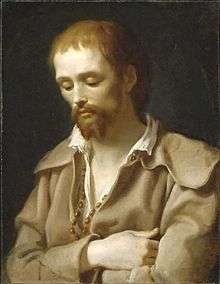Antonio Cavallucci

Antonio Cavallucci (21 August 1752 – 18 November 1795) was an Italian painter of the late Baroque.
Biography

Cavallucci was born in Sermoneta in the Lazio. His artistic talents were recognized in an early stage by Francesco Caetani, Duke of Sermoneta in 1738-1810. In 1765, he brought the 13-year-old Cavallucci to Rome, where he became a pupil of Stefano Pozzi and three years later of Gaetano Lapis. He also studied drawing at the Accademia di San Luca (c. 1769-1771).
His earliest work dates from the mid-1760s. It is a tempera frieze in the Casa Cavallucci in Sermoneta. His first portrait was of his benefactor Duke Francesco Caetani. This portrait is only preserved as an engraving in 1772 by Pietro Leone Bombelli (1737–1809).
His first major commission was the decoration of five audience chambers in the Caetani Palace in Rome in 1776. He painted mythological scenes and allegories appropriate for each room.
In the early 1780s he painted mostly portraits, such as those of Francesco Caetani and Teresa Corsini, Duchess of Sermoneta.
The Origin of Music (1786) is probably the most important painting of his mid-career. It was based on the illustrations in the book Iconologia (1593) from Cesare Ripa.
The commissions kept coming under his new patron, Cardinal Romualdo Braschi-Onesti (1753–1817), nephew of the pope Pius VI. He has painted the portraits of his new benefactor and of the pope in 1788.
He was inducted into the Accademia di San Luca in 1786, Academy of Arcadia in 1788, and the Congregazione dei Virtuosi al Pantheon in 1788.
He is said to have painted St Benedict Joseph Labre while the saint was in ecstasy, or (as is perhaps more plausible), having seen the saint in ecstasy, to have brought him to his studio and painted his portrait there. In later years he worked for Cardinal Francesco Saverio Zelada, decorating his titular church San Martino ai Monti in Rome. Cavallucci died in Rome in 1795.
He was influenced by Pompeo Batoni and Anton Raphael Mengs. There is in his art some of the northern European feeling that had made its way into Rome at the end of the eighteenth century. The Portuguese painter Domingos Sequeira was one of his pupils.
Selected works
- Abigail before David (1773)
- Departure of Hector and Andromache (1773)
- Crucifixion with Saints (1773)
- Presentation of the Virgin (1786) in the Cathedral of Spoleto
- Thomas of Cori (levitation) (1786), Eucharistic museum of Hieron, Paray-le-Monial, France
- Venus with Ascanius, at the Palazzo Cesarini in Rome
- Investiture of St Bona(1791), Cathedral of Pisa
- Principe del Belvedere (1793), Gallerie di Capodimonte, Naples
- St. Elias and the Purgatory (1793) S. Martino ai Monti, Rome
- Altar piece in the Church of San Nicolò in Catania, Sicily
- St Francis announces the Pardon to the people in the Chapel of St Diego d’Alcalà in the Basilica of Santa Maria degli Angeli in Assisi.
References
- Enciclopedia Italiana di Scienze, Lettere ed Arti. Rome: Istituto della Enciclopedia Italiana. Vol. IX, p. 557.
- Turner, Jane (ed.) (1996). Grove Dictionary of Art. Macmillan Publishers. ISBN 1-884446-00-0.
- Farquhar, Maria (1855). Ralph Nicholson Wornum, ed. Biographical catalogue of the principal Italian painters. Woodfall & Kinder, Angel Court, Skinner Street, London; Digitized by Googlebooks from Oxford University copy on Jun 27, 2006. p. 44.